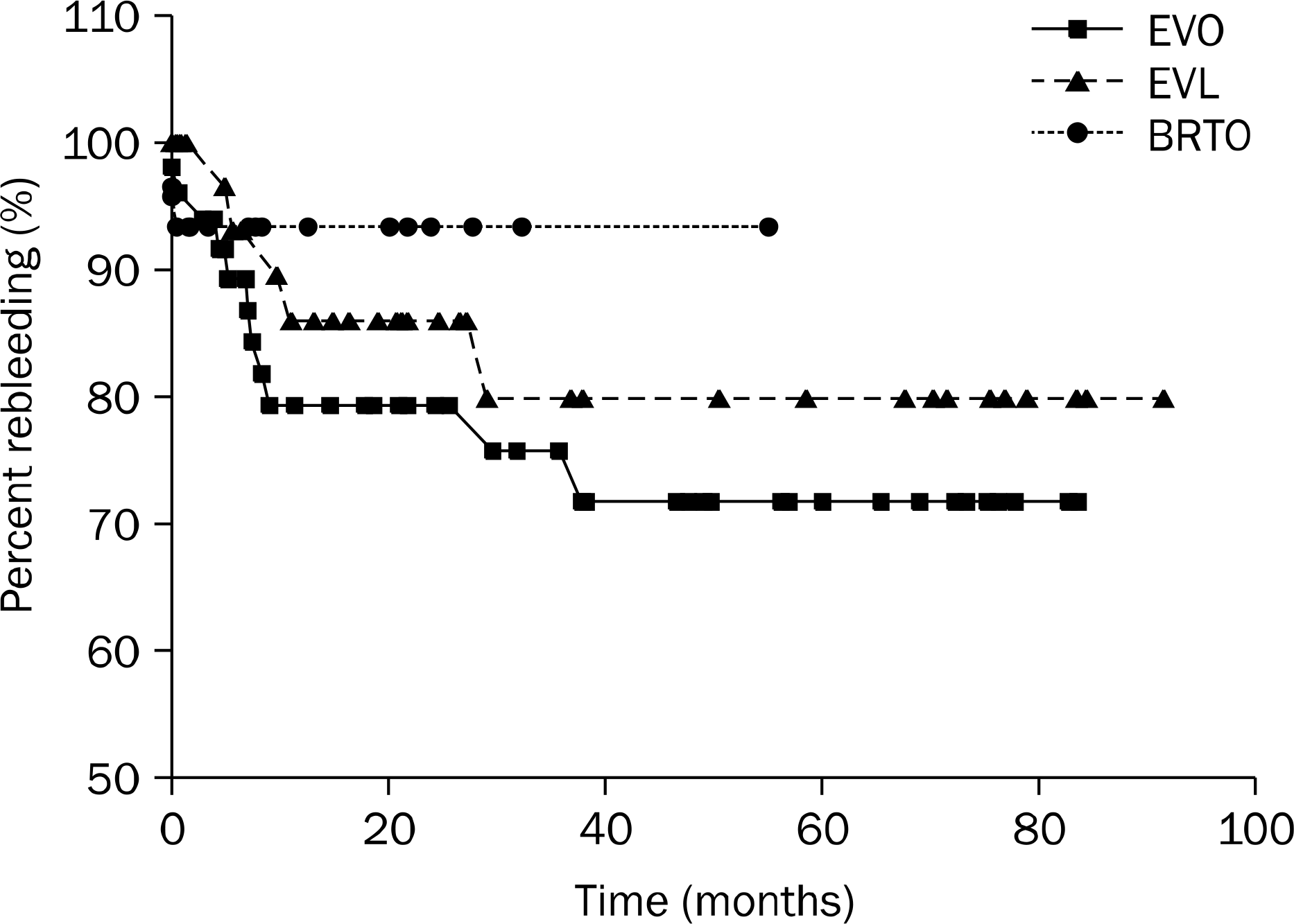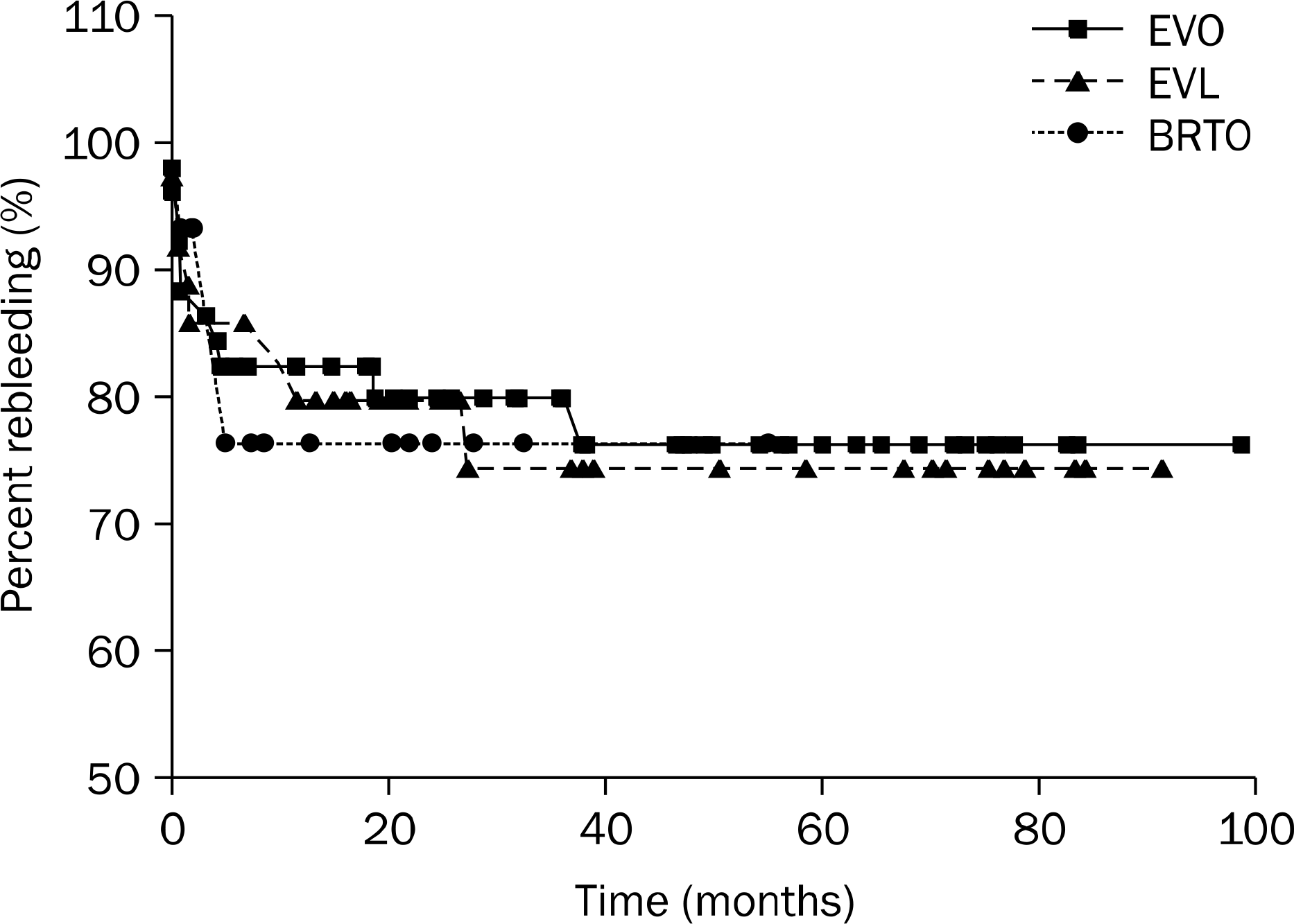Abstract
Background/Aims
Endoscopic variceal obliteration (EVO), endoscopic variceal ligation (EVL), and balloon-occluded retrograde transvenous obliteration (BRTO) are used to manage gastric variceal bleeding. We compared the rebleeding rates and survival times of these modalities.
Methods
The study enrolled 103 patients with suspected gastric variceal bleeding between July 2001 and May 2009. For the management of gastric variceal bleeding, 52 patients underwent EVO; 36, EVL; and 15, BRTO. We evaluated their laboratory results and vital signs, and calculated the Child score, Child classification, and Model for End-stage Liver Disease score. Rebleeding was defined as new-onset hematemesis, hematochezia, melena, or endoscopically proven bleeding. Time-to-rebleeding and survival time were examined by Kaplan-Meyer analysis. A value of p<0.05 indicated statistical significance.
Results
There were no significant differences in baseline characteristics among the three groups. The overall follow-up period averaged 65.13 months. During follow-up, rebleeding occurred in 17 patients (11 EVO, 5 EVL, and 1 BRTO). The times-to-rebleeding were 63.59, 75.79, and 51.41 months for EVO, EVL, and BRTO, respectively, and did not differ significantly (p=0.515). The median survival times were 77.42, 70.14, and 42.79 months, respectively, and also were not different significantly (p=0.978).
References
1. Sarin SK, Kumar A. Gastric varices: profile, classification, and management. Am J Gastroenterol. 1989; 84:1244–1249.
2. Greig JD, Garden OJ, Anderson JR, Carter DC. Management of gastric variceal haemorrhage. Br J Surg. 1990; 77:297–299.

3. Sarin SK, Lahoti D, Saxena SP, Murthy NS, Makwana UK. Prevalence, classification and natural history of gastric varices: a long-term follow-up study in 568 portal hypertension patients. Hepatology. 1992; 16:1343–1349.

4. Hashizume M, Sugimachi K. Classification of gastric lesions associated with portal hypertension. J Gastroenterol Hepatol. 1995; 10:339–343.

5. Ohnishi K, Saito M, Sato S, et al. Direction of splenic venous flow assessed by pulsed Doppler flowmetry in patients with a large splenorenal shunt. Relation to spontaneous hepatic encephalopathy. Gastroenterology. 1985; 89:180–185.
6. Watanabe K, Kimura K, Matsutani S, Ohto M, Okuda K. Portal hemodynamics in patients with gastric varices. A study in 230 patients with esophageal and/or gastric varices using portal vein catheterization. Gastroenterology. 1988; 95:434–440.
7. Arakawa M, Masuzaki T, Okuda K. Pathomorphology of esophageal and gastric varices. Semin Liver Dis. 2002; 22:73–82.

8. Wu CY, Yeh HZ, Chen GH. Pharmacologic efficacy in gastric variceal rebleeding and survival: including multivariate analysis. J Clin Gastroenterol. 2002; 35:127–132.
9. Lo GH, Liang HL, Chen WC, et al. A prospective, randomized controlled trial of transjugular intrahepatic portosystemic shunt versus cyanoacrylate injection in the prevention of gastric variceal rebleeding. Endoscopy. 2007; 39:679–685.

10. Soehendra N, Nam VC, Grimm H, Kempeneers I. Endoscopic obliteration of large esophagogastric varices with bucrylate. Endoscopy. 1986; 18:25–26.

11. Japanese Research Society for Portal Hypertension. The general rules for recording endoscopic findings on esophageal varices. Jpn J Surg. 1980; 10:84–87.
12. Feretis C, Tabakopoulos D, Benakis P, Xenofontos M, Golematis B. Endoscopic hemostasis of esophageal and gastric variceal bleeding with Histoacryl. Endoscopy. 1990; 22:282–284.

13. Kanagawa H, Mima S, Kouyama H, Gotoh K, Uchida T, Okuda K. Treatment of gastric fundal varices by balloon-occluded retrograde transvenous obliteration. J Gastroenterol Hepatol. 1996; 11:51–58.

14. Hirota S, Matsumoto S, Tomita M, Sako M, Kono M. Retrograde transvenous obliteration of gastric varices. Radiology. 1999; 211:349–356.

15. Choi YH, Yoon CJ, Park JH, Chung JW, Kwon JW, Choi GM. Balloon-occluded retrograde transvenous obliteration for gastric variceal bleeding: Its feasibility compared with transjugular intrahepatic portosystemic shunt. Korean J Radiol. 2003; 4:109–116.

16. Baik GH, Kim DJ, Lee HG, et al. Therapeutic efficacy of balloon-occluded retrograde transvenous obliteration in the treatment of gastric varices in cirrhotic patients with gastrorenal shunt. Korean J Gastroenterol. 2004; 43:196–203.
17. Garcia-Pagán JC, Bosch J. Endoscopic band ligation in the treatment of portal hypertension. Nat Clin Pract Gastroenterol Hepatol. 2005; 2:526–535.

18. Hashizume M, Kitano S, Yamaga H, Koyanagi N, Sugimachi K. Endoscopic classification of gastric varices. Gastrointest Endosc. 1990; 36:276–280.

19. Ramond MJ, Valla D, Mosnier JF, et al. Successful endoscopic obturation of gastric varices with butyl cyanoacrylate. Hepatology. 1989; 10:488–493.

20. Hou MC, Lin HC, Kuo BI, Lee FY, Schmidt CM, Lee SD. Clinical implications of the white nipple sign and its role in the diagnosis of esophageal variceal hemorrhage. Am J Gastroenterol. 1996; 91:2103–2109.
21. Mitchell KJ, MacDougall BR, Silk DB, Williams R. A prospective reappraisal of emergency endoscopy in patients with portal hypertension. Scand J Gastroenterol. 1982; 17:965–968.
22. Kiyosue H, Mori H, Matsumoto S, Yamada Y, Hori Y, Okino Y. Transcatheter obliteration of gastric varices. Part 1. Anatomic classification. Radiographics. 2003; 23:911–920.
23. Koito K, Namieno T, Nagakawa T, Morita K. Balloon-occluded retrograde transvenous obliteration for gastric varices with gastrorenal or gastrocaval collaterals. AJR Am J Roentgenol. 1996; 167:1317–1320.

24. Chikamori F, Kuniyoshi N, Shibuya S, Takase Y. Correlation between endoscopic and angiographic findings in patients with esophageal and isolated gastric varices. Dig Surg. 2001; 18:176–181.

25. Binmoeller KF, Soehendra N. "Superglue": the answer to variceal bleeding and fundal varices? Endoscopy. 1995; 27:392–396.

26. Huang YH, Yeh HZ, Chen GH, et al. Endoscopic treatment of bleeding gastric varices by N-butyl-2-cyanoacrylate (Histoacryl) injection: long-term efficacy and safety. Gastrointest Endosc. 2000; 52:160–167.

27. Lo GH, Lai KH, Cheng JS, Chen MH, Chiang HT. A prospective, randomized trial of butyl cyanoacrylate injection versus band ligation in the management of bleeding gastric varices. Hepatology. 2001; 33:1060–1064.

28. Sarin SK, Jain AK, Jain M, Gupta R. A randomized controlled trial of cyanoacrylate versus alcohol injection in patients with isolated fundic varices. Am J Gastroenterol. 2002; 97:1010–1015.

29. Tan YM, Goh KL, Kamarulzaman A, et al. Multiple systemic emb-olisms with septicemia after gastric variceal obliteration with cyanoacrylate. Gastrointest Endosc. 2002; 55:276–278.

30. Roesch W, Rexroth G. Pulmonary, cerebral and coronary emboli during bucrylate injection of bleeding fundic varices. Endoscopy. 1998; 30:S89–S90.

31. Akahoshi T, Hashizume M, Shimabukuro R, et al. Longterm results of endoscopic Histoacryl injection sclerotherapy for gastric variceal bleeding: a 10-year experience. Surgery. 2002; 131(1 Suppl):S176–S181.

32. Evrard S, Dumonceau JM, Delhaye M, Golstein P, Devière J, Le Moine O. Endoscopic histoacryl obliteration vs. propranolol in the prevention of esophagogastric variceal rebleeding: a randomized trial. Endoscopy. 2003; 35:729–735.

33. Laine L, Cook D. Endoscopic ligation compared with sclerotherapy for treatment of esophageal variceal bleeding. A metaanalysis. Ann Intern Med. 1995; 123:280–287.
34. Lo GH, Lai KH, Cheng JS, et al. Endoscopic variceal ligation plus nadolol and sucralfate compared with ligation alone for the prevention of variceal rebleeding: a prospective, randomized trial. Hepatology. 2000; 32:461–465.

35. Kim ES, Park SY, Kwon KT, et al. The clinical usefulness of balloon occluded retrograde transvenous obliteration in gastric variceal bleeding. Korean J Hepatol. 2003; 9:315–323.
Fig. 1.
Kaplan-Meier plots of time to rebleeding. EVO, endoscopic variceal obliteration; EVL, endoscopic variceal ligation; BRTO, balloon-occluded retrograde transvenous obliteration.

Fig. 2.
Kaplan-Meier plots of time to survival. EVO, endoscopic variceal obliteration; EVL, endoscopic variceal ligation; BRTO, balloon-occluded retrograde transvenous obliteration.

Table 1.
Baseline Characteristics of Patients
Table 2.
Analysis of Time to Rebleeding
| Number of patients with rebleeding (%) | Mean time to rebleeding (months) | p-value | |
|---|---|---|---|
| EVO | 11/52 (21.2) | 63.59 (53.42–73.77) | 0.515 |
| EVL | 5/36 (13.9) | 75.79 (63.39–88.19) | |
| BRTO | 1/15 (6.7) | 51.41 (44.55–58.27) |




 PDF
PDF ePub
ePub Citation
Citation Print
Print


 XML Download
XML Download